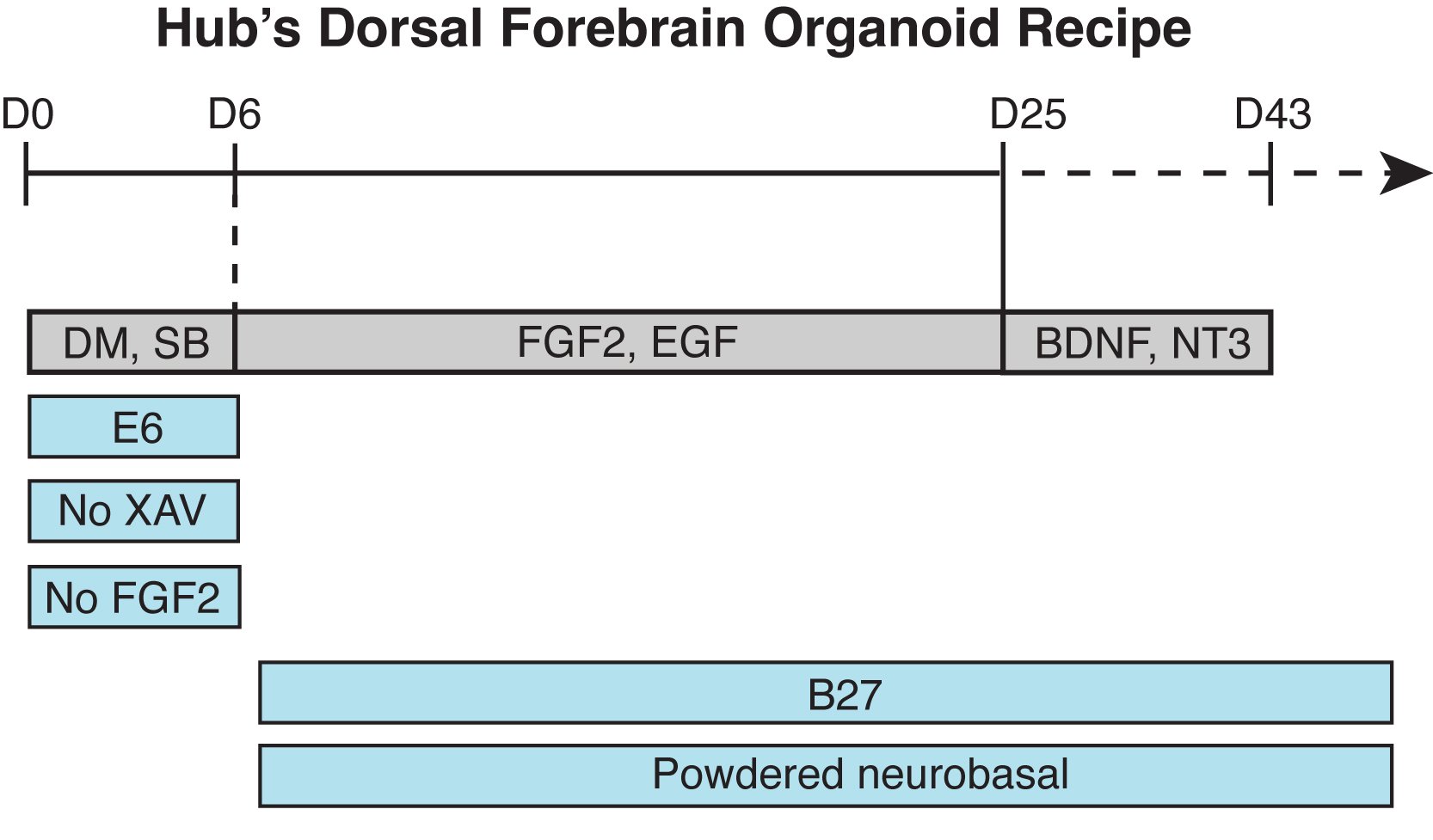Blog Post 1: Benchmarking the components of dorsal forebrain organoid protocols
Question: One of the most common questions we receive is which media components in brain organoid cultures are swappable with alternatives. How much difference does each of these variables make?
To adress this question, as part of of the hub’s first test, we focused on commonly used components of dorsal forebrain protocols and asked which ones make the most difference in inducing the dorsal forebrain fate, and which ones are interchangable/optional.
TL;DR:
-All conditions broadly result in forebrain commitment despite differences.
-Composition of the induction media (NIM vs E6) is what makes the most difference.
-Significant cost-saving options by using homemade B27 (NS19) and/or powdered neurobasal.
Design:
- Our base recipe (in grey blocks on the left) is based on our previously published protocol.
- We used two hiPSC lines. These lines are derived from different sexes, backgrounds, fibroblast ages, and even reprogramming methods.
Findings: Here is a heatmap summarizing our findings. We are visualizing the expression of canonical dorsal forebrain markers. Scroll down for a detailed breakdown!
Feb 12th, 2023
Comparison 1: NIM vs E6
Over time, we noticed that some hiPSC lines would fall apart in E6 alone, but would pull through in NIM. That being said, NIM contains a few additional factors, including Knockout Serum Replacement (KSR), which is expensive and can be prone to batch-batch variability compared to the chemically defined recipe of E6.
Choice of neural induction media did seem to have an impact on differentiation, as can be seen most clearly in line 1 here.
NIM-induced dorsal forebrain organoids had lower expression of canonical forebrain markers like FOXG1 and TBR1 compared to E6.
Verdict: E6 is better at inducing forebrain fate than NIM.
Comparison 2: +/- XAV
XAV-939 is a commonly used WNT inhibitor that has been reported to improve dorsal forebrain patterning in some culture conditions.
At least with the 2 lines we tested, XAV had little impact on differentiation.
The only benefit we saw was that XAV was able to somewhat increase the expression of forebrain markers, especially in organoids induced by NIM.
Verdict: XAV enhances dorsal forebrain fate
in NIM conditions, marginal effects with E6.
Comparison 3: +/- FGF2
FGF2 throughout initial 3D formation can help improve organoid size and viability, so we wanted to test if this had a beneficial or detrimental effect on overall differentiation.
FGF2 had noticable effects on these cultures.
Of note, all organoids receiving this extra 5 days of FGF2 were noticeably larger. However, this also had consequences on differentiation.
Verdict: Early FGF2 potentially impairs
dorsal forebrain fate induction.
Comparison 4: B27 vs NS19
B27 is a serum-free supplement commonly used in neuronal cultures. It is often susceptible to shortages and backordering issues.
There are several alternatives, but one homemade option is NS21 . NS21 includes two retinol (Vitamin A) derivatives, so we left these out to mimic B27 minus Vitamin A. Therefore, we call our recipe “NS19”. NS19 is significantly cheaper, but does take considerable time to make the recipe frequently.
We could not distinguish between cultures with B27 or NS19.
Verdict: As a cheaper alternative, NS19 is comparable to B27.
Comparison 5: Pre-made vs powdered neurobasal
The most widely used media in our organoid cultures is by far Neurobasal-A. The hub sometimes uses close to 1 liter in a day! Purchasing this directly from the supplier (Thermo) can be time-saving, but is also costly and susceptible to supply chain dynamics.
A while back, we stumbled upon a powdered version of Neurobasal-A, which at list price can come in somewhere around 10-20x cheaper. It also minimizes lot-to-lot variability and can be purchased in bulk to avoid shortages. Finally, it’s super easy to make and only requires pH & osmolality testing after resuspension.
There doesn’t seem to be any significant effect between powdered vs formulated Neurobasal in terms of differentiation.
The Sloan Lab switched to powder about a year ago and have never seen an impact over dozens of differentiations and more than 8 lines.
Verdict: As a cheaper alternative, powder neurobasal-A is comparable to pre-made neurobasal-A.
Based on these results, the hub has now adopted the following dorsal forebrain organoid recipe:
Thank you for reading!
Questions, comments, suggestions?
Please email our manager Alexia King at alexia.tyler.king@emory.edu
See you at the next post!
FGF2 had slightly negative affects on forebrain induction (lower expression of forebrain markers) although we need a larger sample size to definitively say so.
To jump to the results related to specific comparisons:
















